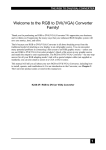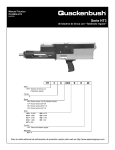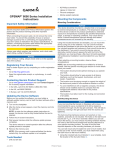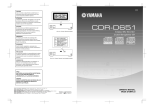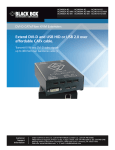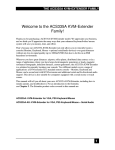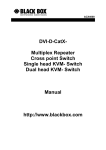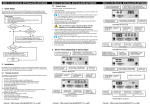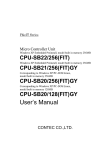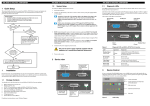Download CHEETAH V5 DVI/RGBHV Extenders
Transcript
CHEETAH V5 MODULES CHEETAH V5 DVI/RGBHV Extenders July 26, 2005 Manual: 81-9059-0571-0 Revision B 1 CHEETAH V5 MODULES 81-9059-0571-0 REV.B Copyrights and Trademarks ©2004. All rights reserved. This information may not be reproduced in any manner without the prior written consent of the manufacturer. Information in this document is subject to change without notice and the manufacturer shall not be liable for any direct, indirect, special, incidental or consequential damages in connection with the use of this material. All trademark and trade names mentioned in this document are acknowledged to be the property of their respective owners. Disclaimer While every precaution has been taken in the preparation of this manual, the manufacturer assumes no responsibility for errors or omissions. Neither does the manufacturer assume any liability for damages resulting from the use of the information contained herein. The manufacturer reserves the right to change the specifications, functions, or circuitry of the product without notice. The manufacturer cannot accept liability for damage due to misuse of the product or due to any other circumstances outside the manufacturer’s control (whether environmental or installation related). The manufacturer shall not be responsible for any loss, damage, or injury arising directly, indirectly, or consequently from the use of this product. Cautions and Notes The following symbols are used in this guide: CAUTION. This indicates an important operating instruction that should be followed to avoid any potential damage to hardware or property, loss of data, or personal injury. NOTE. This indicates important information to help you make the best use of this product. 2 DECLARATION OF CONFORMITY EUROPEAN UNION DECLARATION OF CONFORMITY This is to certify that, when installed and used according to the instructions in this manual, together with the specified cables and the maximum cable length <3m, the Units are shielded against the generation of radio interferences in accordance with the application of Council Directive 89/336/EEC as well as these standards: EN 55022: Fiber+STP 1999 Class B EN 55022: UTP 1999 Class A EN 55024: 1999 IEC 61000-4-2: 2001 IEC 61000-4-3: 2001 IEC 61000-4-4: 2001 EN 61000-3-2 2001 EN 61000-3-3 2002 The device was tested in a typical configuration with PC. 3 CHEETAH V5 MODULES 81-9059-0571-0 REV.B Safety Precautions and Installation Guidelines To ensure reliable and safe long-term operation, please note the following installation guidelines: • Only use in dry, indoor environments. • If the building has 3-phase AC power, try to ensure that equipment connected to the Local and Remote units is on the same phase. • Ensure that the system connected to the Local unit is connected to power ground. • Ensure that the monitor connected to the Remote unit is connected to power ground and does not use an isolated power supply. • The Remote unit, Local unit and any power supplies can get warm. Do not locate them in an enclosed space without any airflow. • Do not place a power supply directly on top of a unit. • Do not obstruct a unit’s ventilation holes. To safeguard against personal injury and avoid possible damage to equipment or property, please observe the following: 4 • Only use power supplies originally supplied with the product or manufacturer-approved replacements. Do not attempt to dismantle or repair any power supply. Do not use a power supply if it appears to be defective or has a damaged case. • Connect all power supplies to grounded outlets. In each case, ensure that the ground connection is maintained from the outlet socket through to the power supply’s AC power input. • Do not attempt to modify or repair this product, or make a connection from the Fiber link interface (LC) to any other products, especially telecommunications or network equipment. SAFETY PRECAUTIONS AND INSTALLATION GUIDELINES Optical Models These are Class 1 Laser products. Singlemode transceivers comply with IEC 60825-1 and FDA 21 CFR 1040.10 and 1040.11. To meet laser safety requirements, the transceivers shall be operated within the absolute maximum ratings. The use of optical instruments with this product may cause an eye hazard. All adjustments have been made at the factory prior to shipment of the device. No maintenance or alteration to the device is required. Tampering with or modifying the performance of the device will result in voided product warranty. Usage Restrictions Optical ports must be terminated with an optical connector or with a dust plug. Failure to adhere to the above restrictions could result in a modification that is considered an act of “manufacturing” and will require, under law, recertification of the modified product with the U.S. Food and Drug Administration (ref. 21 CFR 1040.10(i)). 5 CHEETAH V5 MODULES 81-9059-0571-0 REV.B Contents 1. Quick Setup 1.1 Video Input/Output 1.2 Command Summary 7 8 9 2. Overview 2.1 Introduction 2.2 Glossary 2.3 Features 2.4 Product Range 2.5 Compatibility 2.6 How to Use This Guide 9 9 10 13 14 15 16 3. Installation 16 3.1 Package Contents 3.2 Interconnection Cable Requirements 3.3 System Setup 3.4 Diagnostic LEDs 16 17 18 20 4. Device Control Opening the OSD 4.1 4.2 Using the OSD 20 22 24 5. Monitor Setup 32 6. Extender Setup 6.1 Overview 6.2 Setup Instructions for VGA Input 33 33 34 7. Troubleshooting 7.1 Video 35 35 Appendix A: Rack Mount Options 38 Appendix B: System Upgrade 40 Appendix C: Video Modes and Frame Rates 41 Appendix D: Audio Option 43 Appendix E: Calling Technical Support 45 Appendix F: Specifications 46 Appendix G: Connectors and Cables 48 6 QUICK SETUP This section briefly describes how to install your Cheetah V5 system and optimize the video signals. Unless you are an experienced user, we recommend that you follow the full procedures described in the rest of this manual. Refer to the command summary on page 9 when following this procedure. Install system 1. 2. 3. 4. Connect Remote unit (RX) to source. Connect Local unit (TX) to CPU or switch. Connect Local and Remote units with matching interconnection cable (Singlemode fiber). Power up the system. No Do you have a DVI monitor? Yes No Do you have a flat screen (TFT)? Yes Carry out the Monitor Setup procedure (please refer to its manual and see page 40 in this manual). Do you have a DVI source? Yes No Carry out VGA Input Setup procedure (please follow the instructions on page 42). Done 7 CHEETAH V5 MODULES 81-9059-0571-0 REV.B VIDEO INPUT/OUTPUT If possible, always use DVI output from your computer’s video card and DVI input to a monitor. This provides the optimum video signal. If you use a VGA output from your graphic source, the DVI Local unit must digitize the signal prior to transmission. Similarly, if your remote TFT screen uses a VGA input, it must digitize the signal from the Remote unit. In both cases, the built-in video processors must determine the resolution and pixel phase for an optimized digitization. Your DVI Extender allows you to optimize the video signal manually or automatically using its on-screen utility (see Chapter 4). If you are using a VGA input to a TFT monitor, please follow the manufacturer’s instructions. You may have several possible options for video source output/monitor input. If this is the case, for the optimum video quality, please select the highest ranked available combination from the following table: 8 Video Quality Local Unit input Remote Unit output 1 DVI DVI 2 DVI VGA 3 VGA DVI 4 VGA VGA COMMAND SUMMARY The following table summarizes the ‘hot’ key command sequences used in system configuration and video tuning on a Remote unit console. Command Keyboard at Remote unit Terminal or Windows Utility program* Enter OSD <Left Control> + <Left Shift> + <I> <O> + <S> + <D> + <Enter> Exit OSD <ESC> <X> Select next position <Right Arrow> <R> Select previous position <Left Arrow> <L> Select Submenu <Enter> <S> Select parameter modification <Enter> <S> Increase parameter <Right Arrow> <R> Decrease parameter <Left Arrow> <L> Accept and store modified parameter <Enter> <S> Back to the Menu selection * Commands are not case-sensitive. OVERVIEW INTRODUCTION A basic Cheetah V5 system comprises a Local unit (transmitter) and a Remote unit (receiver). The Local unit connects directly to the computer using the supplied cable(s). The user console (monitor) attaches to the Remote unit. The Remote and Local units communicate video information along the interconnecting cable (see Figure 1). Local units offer dual access, allowing the connection of a second user console close to the computer. With the optional V5A2 models, you can also use the Cheetah V5 units to communicate stereo audio. Cheetah V5 modules enable high-resolution video and optional stereo audio to be communicated up to: • 1200ft (400m) over Multimode fiber cable (50/125µ). • 600ft (200m) over Multimode fiber cable (62.5/125µ). • 6¼ miles (10km) over Singlemode fiber cable (9/125µ). In a digital application (DVI input and output), there is no loss of picture quality irrespective of extension distance and no adjustments are required. The Cheetah V5 modules also support traditional analog VGA as well as digital DVI. All combinations of DVI and VGA (graphics cards and monitors) are supported, allowing equipment to be mixed. In a mixed analog/digital application, some adjustment of the video signal is necessary to optimize the analog-digital signal conversions. Cheetah V5 modules are equipped with various automatic and manual video correction tools in an on screen utility (see page 20). 9 CHEETAH V5 MODULES GLOSSARY The following terms are used in this guide: Multimode Any multimode fiber cable 50/125µ or 62.5/125µ Singlemode Any singlemode fiber cable 9/125µ PSU The desktop power supply connected to the Local/Remote unit. Dual Access A system allowing connection of Local and Remote user consoles. Single Head An extender system that supports one monitor. Coax Recommended coax is Belden 8281 or equal 10 81-9059-0571-0 REV.B Local Access LOCAL unit REMOTE unit Audio extension options Video Support Figure 1 Cheetah V5 System 11 CHEETAH V5 MODULES 12 81-9059-0571-0 REV.B FEATURES The Cheetah V5 Modules offer the following features: • Support for high video resolution over extended distances: 1600x1200@60Hz over all allowed distances all lower resolutions with refresh rates of at least 75Hz • All models come with dual access, to allow local or remote operation (Local DVI access limited to screen resolutions up to 1280x1024). • All control and video tuning carried out using an on screen display (OSD) with settings stored in EEPROM memory. • Local/Remote unit firmware and settings flash upgradeable. • Stereo audio (16-bit digitized) support on certain models enables high-quality, low-noise audio extension. • Status indicator LEDs on each device. • Small footprint chassis. • Rack mount options available. • CPU cables + Adapters included. 13 CHEETAH V5 MODULES PRODUCT RANGE There are two products in the ranges: Primary Modules- Video Only CH1612TX-V5 DVI/VGA Extender, Singlemode Transmitter CH1612RX-V5 DVI/VGA Extender, Singlemode, Receiver CH1612TX-V5C DVI/VGA Extender, Coax, Transmitter CH1612RX-V5C DVI/VGA Extender, Coax, Receiver CH1612TX-V5R DVI/VGA Extender, Singlemode, Transmitter, Rackmount CH1612RX-V5R DVI/VGA Extender, Singlemode, Receiver, Rackmount CH1612TX-V5CR DVI/VGA Extender, Coax, Transmitter, Rackmount CH1612RX-V5CR DVI/VGA Extender, Coax, Receiver, Rackmount Primary Modules-Video and Audio CH1612TX-V5A2 DVI/VGA Stereo Audio, Singlemode Transmitter CH1612RX-V5A2 DVI/VGA Stereo Audio, Singlemode Receiver CH1612TX-V5A2C DVI/VGA Stereo Audio Extender, Coax, Transmitter CH1612RX-V5A2C DVI/VGA Stereo Audio Extender, Coax, Receiver CH1612TX-V5A2R DVI/VGA Stereo Audio Extender, Singlemode, Transmitter, Rackmount CH1612RX-V5A2R DVI/VGA Stereo Audio Extender, Singlemode, Receiver, Rackmount CH1612TX-V5A2CR DVI/VGA Stereo Audio Extender, Coax, Transmitter, Rackmount CH1612RX-V5A2CR DVI/VGA Stereo Audio Extender, Coax, Receiver, Rackmount Upgrade Kits CHV5RMKIT Rack mount kit for above modules, 1RU, supports up to three modules CHV5-DVICABLE Cable DVI CHV5RMKIT3RU 3RU Frame, allows for up to 9 modules of any “-R” model. Internal power supply and cooling fan. 14 81-9059-0571-0 REV.B COMPATIBILITY Interface Compatibility • (OPTION) Audio: Input and output are line-level. Amplified speakers are required. • Analog Video: VGA to UXGA. Supports RGB, RGsB, RGBHV. Maximum resolution and refresh rates depend on cable length and cable type • Digital Video: DVI single link for resolution up to 1600x1200 at 60Hz. Frame rates and colors depend on device type 15 CHEETAH V5 MODULES 81-9059-0571-0 REV.B HOW TO USE THIS GUIDE This guide describes the installation and configuration of the Cheetah V5 modules. Although the connection and operation of the system is relatively straightforward, you should consider the following before getting started: Connection & Compatibility If you have purchased an Extender Kit, this will contain all the cables required to connect the Local unit to your PC. The Remote monitor and any audio connects directly to the Remote unit. For information about connection and installation, see Installation, page 16. Interconnection Cable For Cheetah V5 connections, use singlemode or multimode fibers (see Interconnection Cable Requirements, page 17. Adjusting Video Due to the digital nature of the transmitted signals, there is no distortion of video signals or skew problem. If you do not have a DVI source and a DVI monitor, you will need to adjust the monitor and/or the Extender to the picture width and the pixel phase. You can do this using the Auto Adjust or Manual Adjust procedures. • For experienced users there is a Quick Setup section at the start of this guide (see page 7). • For the full procedure, see Monitor Setup and/or Extender Setup. INSTALLATION For first-time users, we recommend that you carry out a test placement, confined to a single room, before commencing full installation. This will allow you to identify and solve any cabling problems, and experiment with the Cheetah V5 system more conveniently. PACKAGE CONTENTS You should receive the following items in your extender package (all types): • Extender Remote unit. • 6V DC 12W universal power supply for Remote unit. • Extender Local unit. • 6V DC 12W universal power supply for Local unit. • 2x DVI-I to VGA adapter (DVI-I dual link male to HD15 female) connector. • 1x VGA to DVI-I adapter (HD15 male to DVI-I dual link female) connector. • Programming cable (DB9 female to RJ11 4p4c). • User manual. • 2x US-type power cord. If anything is missing, please contact Technical Support (see Appendix E: Calling Technical Support). 16 INTERCONNECTION CABLE REQUIREMENTS To connect the Local and Remote units you will need: • Multimode Modules: single fiber cable 50µm or 62.5µm. • Singlemode Modules: single fiber cable 9µm. • Coax Modules: single coax cable, 8281 Belden or equal type coax. • • Power Supply Connect the supplied 6V/DC power supplies to the Plug terminal on the rear of both Local and Remote units. 17 CHEETAH V5 MODULES 81-9059-0571-0 REV.B SYSTEM SETUP To install your Cheetah V5 system: 1. Switch off all devices. 2. Connect your monitor to the Remote unit 3. Connect the interconnect cable to the INTERCONNECT socket(s) as shown 4. Connect the 6V power supply to power the unit. Only use the power supply originally supplied with this equipment or a manufacturer-approved replacement. 5. 18 Power up the system. INTERCONNECT – carries video and data signals – connect to Local unit Programming connector – for firmware upgrades Figure 2 DVI-I Connector – DVI and VGA output – connect to Remote console monitor Connect 6V Power supply Cheetah V5 Remote Unit INTERCONNECT – carries video and data signals – connect to Remote unit Connect 6V Power supply Connect to Local console monitor Connect to CPU video card output DVI-I Connectors (Digital or Analog) Figure 3 Programming connector – for firmware upgrades Cheetah V5 Local Unit 19 CHEETAH V5 MODULES 81-9059-0571-0 REV.B DIAGNOSTIC LEDS Each Extender unit is fitted with four indicator LEDs: Communication Error, Link Status, Device Ready and Video Signal. The Indicator LEDs are located in the same positions on all models. The Communication Error and Link Status LEDs are to the left and right, respectively, of the Interconnect sockets. The Device Ready and Video Signal LEDs are next to the Power socket. As an example, the location of the LEDs is shown below for Remote and Local units: Communication Error Video Signal (Green) Figure 4 Link Status Device Ready (Red) Communication Error Device Ready (Red) Link Status Video Signal (Green) Diagnostic LEDs on Remote (left) and Local (right) units LED Appearance Diagnostics Communication Error Off Flashing No communication error for >60 minutes Indicates number of communication errors during previous 60 minutes: 1-2 (Fiber) 3-10 (Fiber) 10 (Fiber) slow medium fast Error counter cleared automatically 60 minutes after previous communication error. Link Status On Flashing Link connection is locked Interconnection cable not connected or not functioning Device Ready (Red LED) Off On Device not ready Device ready Video Signal (Green LED) Off On No video signal or valid mode detected Attached and valid mode detected DEVICE CONTROL If you are using the DVI output from your video card and the DVI input to a TFT monitor, no adjustment should be required. In other cases, when the video signal is converted between analog and digital formats, either by the Local unit and/or the monitor, you may need to optimize the video signal using the Extender’s on-screen display (OSD). Version information Screen resolution and refresh rate Main menu icons Submenu/command icons Menu title 20 Figure 5 OSD Utility You can adjust the following properties using the OSD: • Adaptation to analog signal sources (VGA/RGB) – see also Monitor Setup, page 32. • Color temperature • Brightness/contrast • Saturation • OSD operation, factory reset. 21 CHEETAH V5 MODULES 81-9059-0571-0 REV.B OPENING THE OSD You can access the OSD in two ways: • Using a standard terminal program with a serial connection to the programming port. • Using our small WINDOWS™ program with a serial connection to the programming port. While the OSD is active, the mouse is locked and only menu keystrokes are allowed at the keyboard. To indicate that the OSD mode is active, the status LEDs (Num Lock, Caps Lock and Scroll Lock) are flashed. There is a summary of OSD commands on page 9. Using a standard terminal program with a serial connection On all devices, you can use a terminal (or terminal software) for OSD access: 1. Connect the programming cable to the programming port of the Local (TX) unit. 2. Connect the programming cable to the serial port of a computer running a terminal client. 3. Set up the terminal to 115200 baud with 8 data bits, no parity and 1 stop bit, ASCII-mode. 4. Type in the following key sequence: < O > + < S > + < D > followed by <ENTER> 22 5. When the OSD starts, it displays information about the attached device and firmware version, for example: DVI-KVM-12lo Vers.1.3 03/05/15 To navigate within the OSD: • Use the <L> and <R> keys to highlight a submenu and/or function. • Press the <S> key to select the highlighted submenu or function. • Select the Exit icon to go back to the previous menu level. • Press the <X> key to exit the OSD mode. Using our WINDOWS™ program On all devices, you can use our small WINDOWS™ program, running on a WINDOWS™ computer for OSD access: 1. Install the OSD program from the supplied CD or download from our website under the pesa/downloads page 2. Connect the programming cable to the programming port of the Local (TX) unit. 3. Connect the programming cable to the serial port of your computer, where the program is running. 4. Start the program and follow the on-screen instructions. 5. Type in the following key sequence: < O > + < S > + < D > followed by <ENTER> When the OSD starts, it displays information about the attached device and firmware version, for example: Modul Name Version Date : DVI-KVM-12lo : Vers.1.3 : 03/05/15 To navigate within the OSD: • Use the <L> and <R> keys to highlight a submenu and/or function. • Press the <S> key to select the highlighted submenu or function. • Select the Exit button to go back to the previous menu level. • Press the <X> key to exit the OSD mode. 23 CHEETAH V5 MODULES 81-9059-0571-0 REV.B USING THE OSD The OSD is an icon-based utility. The top line of symbols shows the main menu categories: Input Select Specify whether the input is analog (VGA) or digital (DVI) Scale Mode Choose whether transmission occurs at the original screen resolution (“transparent”) or the Extender imposes a fixed resolution. Brightness – Contrast Adjust brightness or contrast or reset to default values. Color Adjust color calibration, temperature, flesh/skin tone, hue and saturation. Image VGA Input source only - Adjust pixel clock and phase. Tools Set OSD position and size, fixed scale sharpness, color depth, factory reset. 1. Use the left and right arrow keys (<L> and <R> keys on terminal or in Windows program) to highlight the icon you want. The OSD displays additional icons relating to commands in the selected menu category. 2. Press the Enter key (<S> key on terminal or in Windows program). The OSD highlights the first command icon. 3. Use the Left and Right arrow keys (<L> and <R> keys on terminal or in Windows program) to highlight the command or submenu you want. In the case of the latter, your selection will cause the OSD to display additional command icons (Color Temperature commands, for example). 4. Press the Enter key (<S> key on terminal or in Windows program) to accept a highlighted command. If this requires the increase or decrease of a value (Contrast, for example), the OSD displays a value bar: 5. 24 + Use the Left and Right arrow keys (<L> and <R> keys on terminal or in Windows program) to change the value as required. 6. In many cases, after you have chosen a new setting, the OSD displays the following confirmation message: 7. Highlight the Yes button and press the Enter key (<S> key on terminal or in Windows program) to confirm your choice. Alternatively, highlight the No button and press the Enter key (<S> key on terminal or in Windows program) to discard the new setting and restore the previous value. 8. Select the Exit icon to close a submenu. 9. Press the Esc key (<S> key on terminal or in Windows program) to close the OSD, saving all settings, and restore normal mouse and keyboard functions. The following table summarizes the keyboard actions and icons used to navigate the OSD utility, and to select and adjust the Extender’s parameters: Key/Icon Remote Keyboard Terminal or Windows program Esc <X> Action Close the OSD, restore normal keyboard and mouse functions. Return to previous Menu selection. Enter <S> Open the highlighted menu or submenu Accept the highlighted command Left arrow <L> Select the previous menu or command icon Decrease the highlighted parameter Right arrow <R> Select the next menu or command icon Increase the selected parameter 25 CHEETAH V5 MODULES 81-9059-0571-0 REV.B Input Select Some graphic cards are equipped with both DVI and VGA outputs. On powering up the CPU, the Extender system uses the first detected signal unless you explicitly specify the input type. Use the Input Select menu to specify the type of video signal to be used by the Local unit. The actual graphic source is displayed with a ‘[’ symbol (for example, VGA[). VGA Video input to Local unit DVI Video input to Local unit Return to main menu Figure 6 26 Input Select menu Scale Use the Scale menu to specify whether the Extender system changes the resolution of the input video. You can set the device for transparent transmission. In this case, the Remote unit generates a screen resolution and refresh rate to match that of the source. You can also specify that the output displays at a fixed screen resolution, regardless of that of the input signal. You might want to use a fixed resolution if your monitor is not able to display the generated resolution or, for example, if you have a server farm with many different CPUs each having a different screen resolution. With a transparent transmission, it could take a long time to regain a picture on the screen each time you switch to a different CPU. Transparent transmission: No modification of resolution/refresh rate, Remote unit always generates an exact reproduction of the source signal Choice of three fixed transmissions at refresh rate of 60Hz (for LCD/flat screens) 800x600, 1024x768, 1280x1024 Return to main menu Choice of three fixed transmissions at refresh rate of 75Hz (for CRT/tube screens) 800x600, 1024x768, 1280x1024 Figure 7 Scale Mode menu Downscaling is only available with VGA signals. With a DVI input, you can select downscaling but it will not work – only upscaling has an effect. 27 CHEETAH V5 MODULES 81-9059-0571-0 REV.B Brightness/Contrast Use this menu to adjust the brightness and contrast of the video image, or to adjust the black level of an LCD display. Adjust Brightness Adjust Contrast Adjust Black level Return to main menu Figure 8 Brightness-Contrast menu Select Colors and Color Temperatures Use the Colors menu to adjust the color balance of the video image. The menu provides a number of options including automatic calibration, manual adjustment in RGB or CMY color space, hue and saturation adjustment and the setup of flesh/skin tone. Automatic color calibration Standard RGB color selection View Color temperature submenu (see Color Temperature, page 36) Flesh tone/Skin tone Hue Figure 9 28 Saturation Color menu Set up colors in CMY space – automatically adjusts settings in RGB space Back to main menu Color Temperature Use the Color Temperature submenu to set up the color profile in RGB color space or by using one of five predefined color temperatures. To view this menu, select the Colors icon from the main menu and then select the Color Temperature icon. Set up colors in RGB space – automatically adjusts settings in CMY space Choice of five color temperature settings: 4200k, 5000k, 6500k, 7500k, 9300k Back to Color menu Figure 10 Color Temperature submenu Image VGA inputs only Use the Image menu to adjust the vertical and horizontal screen position and to set the pixel clock and phase. Automatic detection of the number of pixels per line and the best phase (best point for A/D conversion within each pixel) see also Extender Setup, page 41. Back to main menu Manually adjust the vertical screen position Manually adjust the horizontal screen position Manually adjust the number of pixels per line (Pixel clock) Figure 11 Manually adjust the best phase (best point for A/D conversion within each pixel) Image menu 29 CHEETAH V5 MODULES 81-9059-0571-0 REV.B Tools Use the Tools menu to set the position and size of the OSD window, adjust the sharpness for a fixed resolution setting, set the color depth, reset the Extender system to its factory default settings or provide a test pattern. Set the position of the OSD window (see OSD, page 37) Reset Extender to factory default settings Adjust sharpness (fixed resolution modes only). When resolution is changed by an imposed fixed resolution, sharpness can be affected. Use this option to switch between three settings for optimum sharpness Select color depth (see Color Depth, page 39) Display a ‘burst’ pattern at the remote console for monitor setup (see Monitor Setup, page 42) Choose whether to automatically adjust pixels per line and pixel phase after a mode change (see Auto Configuration, page 38) Back to main menu Figure 12 Tools menu OSD Use the OSD submenu to define the position and size of the OSD window. To view this menu, select the Tools icon from the main menu and then select the OSD icon. Manually adjust the horizontal position of the OSD window Manually adjust the vertical position of the OSD window Back to Tools menu Toggle the size of the OSD window between single and double size Figure 13 30 OSD submenu Auto Configuration Use the Auto Configuration submenu to define whether the Local unit carries out automatic detection of the number of pixels per line and the best phase after a mode change (a change of screen resolution and/or refresh rate at the graphic source). Using automatic detection (while displaying an appropriate test pattern) ensures an optimized image but the procedure introduces a delay in the picture appearing on the remote console screen. If you want the picture to appear as fast as possible, and can tolerate a non-optimized image, you may want to disable this feature. Please note that Auto Configuration is disabled in the default factory settings. To view the Auto Configuration menu, select the Tools icon from the main menu and then select the Auto Configuration icon. Disable Automatic detection of pixels per line and phase after a mode change Enable Automatic detection of pixels per line and phase after a mode change Back to Tools menu Figure 14 Auto-Configuration submenu 31 CHEETAH V5 MODULES 81-9059-0571-0 REV.B Color Depth Use the Color Depth submenu to select the color depth of the transmitted screen picture. Transmissions can be in high color mode or low color mode. High color mode produces a better quality image but results in a lower frame rate (fps). Use low color mode if you require fast screen changes, for example video applications. Use high color mode if you need precise images, for example, medical applications. Please see Appendix C: Video Modes and Frame Rates (page 41) for more information about frame rates and supported screen resolutions. Color Depth Color Mode Fiber Low 6 bits/color 18 bits total 262144 colors High 8 bits/color 24bits total 16.78M colors To view this menu, select the Tools icon from the main menu and then select the Color Depth icon. Select low color mode/higher fps Select high color mode/lower fps Back to Tools menu Figure 15 Color Depth submenu MONITOR SETUP This procedure is designed to correct for discrepancies in the video signal due to analog/digital video conversion by the Monitor. You do not need to follow this procedure if you have: • A CRT monitor connected to the Remote unit through the VGA input • A TFT monitor connected to the Remote unit through the DVI input In these cases, there is no need to adjust the monitor because the video format is not converted. Please make sure that you carry out this procedure before Extender Setup (page 33). If you are using a TFT monitor at the remote console with a VGA cable, both the Extender AND the TFT monitor digitize the video data stream and affect video quality. By setting up the TFT monitor first, you ensure that you are correcting discrepancies due solely to the Extender system in the Extender Setup procedure. 1. Connect the Extender system and display the regular desktop in the desired screen resolution. Monitor setup may vary depending on screen resolution and/or refresh rate. 2. Display the OSD utility (see page 22). 3. Select the Tools menu option (see page 30). 4. Select the ‘burst’ pattern option. Your TFT should show fine, 1 pixel wide, black and white vertical stripes over the entire screen. The OSD will stay visible in the middle of the screen. 5. Depending on the type of TFT, press the ‘AUTO’ Button on the monitor control panel or select Auto Adjust in the TFT Setup Menu. Refer to the manual supplied with your monitor for more information. 6. If the vertical stripes are sharp and without jitter or smearing, the adjustment has been successful. Go to step 8. 32 7. If the picture quality is not acceptable after the automatic adjustment, you will have to manually adjust the pixel clock and pixel phase (in this order). Please follow the instructions in your monitor’s user manual. 8. Press any key to exit the test pattern display. 9. Exit the OSD. EXTENDER SETUP OVERVIEW You need to optimize the video signal across your Extender system if it undergoes one or more conversions between analog and digital formats. The exact procedure depends on your Extender setup: Graphics card Monitor type Monitor Input used Video Optimization Procedure(s) TFT adjustment (see Monitor Setup, page 32) Optimization using OSD (see Setup Instructions for VGA Input, page 34) VGA TFT VGA VGA CRT VGA Optimization using OSD (see Setup Instructions for VGA Input, page 34) VGA TFT DVI Optimization using OSD (see Setup Instructions for VGA Input, page 34) DVI TFT VGA TFT adjustment only (see Monitor Setup, page 32) DVI CRT VGA No setup required DVI TFT DVI No setup required 33 CHEETAH V5 MODULES 81-9059-0571-0 REV.B SETUP INSTRUCTIONS FOR VGA INPUT This procedure is designed to correct for discrepancies in the video signal due to analog/digital video conversion by the Extender system. You do not need to follow this procedure if you have a DVI graphics card connected to the Local unit. In this case, the video signal remains in a digital format through the Extender system. If you are using a TFT monitor at the remote console with a VGA cable, you should carry out the Monitor Setup procedure first (see page 32). In this configuration, both the Extender AND the TFT digitize the video data stream and affect video quality. By setting up the TFT monitor, you ensure that you are correcting discrepancies due solely to the Extender system in this procedure. Alternatively, you could replace the TFT monitor with a CRT monitor while you carry out this procedure. You can then reconnect the TFT monitor and optimize its video image afterwards. 1. Download the test pattern from our web server: This is a ‘burst-pattern’ (see Figure 20) - a picture with alternating, 1 pixel wide black and white, vertical stripes. If you are unable to view the test card, display some black text on a white background. For example, you could open Notepad, maximize it to full screen, and fill the page with letter ‘I’s in a 12pt font. Proceed with step 3. 2. Select the burst-pattern graphic as desktop background for the PC: From the Start menu, choose Settings | Control Panel | Display | Backgrounds. Search for the downloaded burst file, using ‘Search for’. Select the tiled display option. Your desktop should show fine black and white vertical stripes over the entire desktop. 3. Display the OSD (see page 22). 4. Select the Image menu option: 5. Select the first command icon: Automatic detection of number of pixels per line and the best phase. 6. Assess the desktop test pattern. If the vertical stripes are sharp and without jitter or smearing, the adjustment has been successful. Go to step 10. 7. If the picture quality is not acceptable after the automatic adjustment, you will have to manually adjust the pixel clock and pixel phase (in this order). 34 8. 9. With a poorly adjusted pixel clock you may see one or more vertical areas, where the lines are smeared (see Figure 16a): a. Return to the OSD utility and select the menu command: Manually adjust the number of pixels per line (Pixelclock) from the Image menu. b. Adjust the pixel clock value until all stripes have disappeared. c. Confirm the setting. Problems with the pixel phase will cause horizontal noise, horizontal wave-formed lines, flicker or smearing with zebra-pattern (see Figure 16b): a. From the OSD’s Image menu, select the menu command: Manually adjust the best phase (best point for A/D conversion within each pixel). b. Modify the phase until all distortions have disappeared. c. Confirm the setting. 10. If appropriate, reattach your TFT monitor and adjust its image according to the manufacturer’s instructions. 11. Reinstall your preferred desktop background picture. (a) Figure 16 (b) Burst test pattern applied to desktop showing problems with (a) pixel clock setting, (b) pixel phase setting. TROUBLESHOOTING VIDEO There isn’t a picture. Check the power supply connection at the Local unit. Is the Device Ready (Red LED) at the Local unit illuminated (see page 20)? If not, the internal power-supply may be damaged or there may be an internal error. Check the power supply connection at the remote unit. Is the Device Ready (Red LED) at the Remote unit illuminated (see page 20)? If not, the internal power-supply may be damaged or there may be an internal error. Check that the Interconnection cable is connected at the Local Unit and the Remote Unit. Is the Link Status LED illuminated (see page 20)? If not, there may be a problem with the Interconnection cable: • Fiber types: Check that the fiber optical cable is correctly connected. The strand connected to the Local Unit’s TX (left-hand connector) must run to the Remote Unit’s RX (right-hand connector) and vice versa. • Fiber types: There may be one or more broken fibers. Do NOT look into a fiber’s end directly while it is connected to a Local or Remote unit! Are the Link Status LEDs at the Local Unit AND at the Remote Unit illuminated? If they are flashing, check for broken fibers using a flashlight. • Fiber types: Are the cables of the recommended fiber type? If you used your own fiber optical cable (not supplied by Black Box), please ensure that you have used 50µ or 62.5µ fiber with a multimode device or a 9µ fiber with a singlemode device. Other fiber-types and polyfibers are not supported. Check that you are using a supported video mode (see Appendix C: Video Modes and Frame Rates). At the Remote Unit, is the Video Signal LED illuminated (see page 20)? 35 CHEETAH V5 MODULES 81-9059-0571-0 REV.B Check your total system configuration. Local units digitize incoming VGA signals and must receive perfect SYNC signals: no glitches, spikes or deformed signals are allowed. Long/wrong or bad cables, or additional components like Splitters or KVM Switches may deform the SYNC signals. Also check that the signals (level and signal form) match the VESA Standard requirements. 36 There is horizontal jitter on the picture. The pixel clock and/or phase is misaligned: Refer to page 34. Characters are smeared. The phase is misaligned: Refer to page 34. Thin vertical lines are missing. The phase is misaligned: Refer to page 34. Colored areas of the screen look like an oil film. In some circumstances, the Extender’s internal video processor may lose its firmware. In this case, it is necessary to reset the unit. A power cycle is NOT sufficient! Please use the OSD to make a Factory Reset (see page 30). 37 NOTES APPENDIX A: RACK MOUNT OPTIONS Extender units can be mounted in a 19” rack using the mounting kit: CHV5RMKIT-Rackmount Kit This contains the following parts: Narrow strip Two small blanking plates Wide blanking plate Base plate M3x5 Screws (14) Figure 17 Rack Mounting Kit To mount a unit: 1. Align the holes on the base plate with the vacant screw holes on the base of the extender unit. 2. Fasten the base of the unit to the plate of the mounting kit using the supplied screws. 3. Close the remaining gaps with blanking plates. NOTES The kit allows you to mount various combinations of regular and double width housings: 1. One regular unit (using two small plates) 2. Two regular units (using one small plate) 3. Mounting of three regular units 4. Mounting of one double width unit (using wide plate) 5. Mounting of double width and regular units ( using narrow strip) NOTES APPENDIX B: SYSTEM UPGRADE System Update / Onboard Programming It is occasionally necessary to update the firmware of the system. Normally, this procedure is carried out in the factory. If you want to update the firmware yourself, contact Technical Support. You will need a programming cable and software to carry out the update. Please follow the supplied instructions carefully. NOTES APPENDIX C: VIDEO MODES AND FRAME RATES The following table shows the video modes supported by the Cheetah V5 modules and the expected frame rates over fiber interconnects or coax interconnects. The Extenders are able to synchronize video modes that do not differ by more than 10% from those listed below. Name Horiz Vert Horiz Vert Dot Clk Pixels Lines kHz Hz MHz DOS graphic Mode 640 350 31.43 70 25.14 Vesa Standard 640 350 37.83 85 31.47 VGA 640 400 24.64 56 20.89 VGA 640 400 31.43 70 25.14 Vesa Standard 640 400 37.86 85 31.50 Vesa Standard 640 480 31.47 60 25.18 Mac Mode 640 480 35.18 67 31.52 Vesa Standard 640 480 37.44 72 31.15 Vesa Standard 640 480 37.50 75 31.50 Vesa Standard 640 480 43.27 85 36.00 DOS Text Mode 720 400 31.43 70 28.29 Vesa Standard 720 400 37.93 85 35.50 NTSC progressive 720 480 31.50 60 27.03 PAL progressive 720 576 31.25 50 27.00 Vesa Standard 800 600 35.16 56 36.00 Vesa Standard 800 600 37.88 60 40.00 Vesa Standard 800 600 48.08 72 50.00 Vesa Standard 800 600 46.88 75 49.50 Vesa Standard 800 600 53.67 85 56.25 Mac Mode 832 624 49.50 75 55.44 Vesa Standard 1024 768 48.36 60 65.00 Vesa Standard 1024 768 56.48 70 75.00 SUN Mode 1024 768 58.03 72 75.21 Vesa Standard 1024 768 60.02 75 78.75 Vesa Standard 1024 768 68.68 85 94.50 DMT1185 1152 864 63.49 70 100.06 Mode 1152 864 63.84 70 94.48 Vesa Standard 1152 864 67.50 75 108.00 SUN Mode 1152 900 61.84 66 94.49 VESA 1280 768 48.12 60 81.23 Vesa Standard 1280 960 60.00 60 108.00 DMT127A 1280 960 75.00 75 126.00 Vesa Standard 1280 960 85.94 85 148.50 Vesa Standard 1280 1024 63.98 60 108.00 SUN mode 1280 1024 70.95 66 115.79 SGI 1280 1024 76.68 72 128.82 HP Workstation B123L 1280 1024 78.12 72 135.00 Vesa Standard 1280 1024 79.98 75 135.00 Vesa Standard 1280 1024 91.15 85 157.50 TV 1400 1050 64.92 60 122.05 SGI 1600 1024 77.62 72 158.34 Vesa Standard 1600 1200 75.00 60 162.00 TV Mode 16:9 1920 1080 66.59 59.934 138.50 WUXGA 1920 1200 74.04 59.95 154.00 NOTES Frame Rates (FPS) The Cheetah V5 is not capable of transferring every frame generated by a graphics card because the net data rate of a Single Link DVI-Interface with 3.9Gbit is much higher than the available transfer rate of the Extenders. Transmission follows the following scheme: • Starting with a recognized VS-Signal, the first frame is digitized (on VGA) and temporarily stored (DVI+VGA) by the Local unit. • The data are transmitted, using the available net data rate, to the Remote unit. During this time, frames generated by the graphic card are discarded without any recognition (frame dropping). • When data transfer is complete, the Extender system waits for the next VS-Signal. Depending on the data volume (affected by the selected screen resolution/refresh rate), the type of transmission module and the correspondence between the duration of the data transfer and a multiple of the refresh rate, you should get frame rates in a range of approximately 15 fps up to the actual refresh rate of the graphic card. The frame rate counts the number of different pictures that are displayed in one second. The monitor is always driven with the same refresh rate as generated by the graphics card or selected in the OSD. The human eye is not able to discern more than 15 fps as single pictures. Your Cheetah V5 modules are therefore suitable for displaying streaming video in the highest resolution. To gain a higher frame rate, reduce the screen resolution - video normally does not require higher resolutions. NOTES APPENDIX D: AUDIO OPTION The Audio option consists of daughter boards that allows for stereo audio to be sent across the regular interconnection cable in addition to VGA/DVI video. To set up the extender’s audio, please follow all of the instructions detailed in this appendix. If you have any questions, contact Technical Support. NOTES Optional Audio Interface - Set Up and Operation The audio interface is line-level and is designed to take the output from a sound card (or other line-level) source and be connected to a set of powered speakers at the other end of the link. Stereo audio may be transmitted over the same fiber link as the video. No set up is required to the remote unit. Connect up the extender as follows: Take the line-level output from your sound card (green connector) and connect to ‘Line In’ on the extender. A set of powered speakers may be connected directly to ‘Line Out’ at the opposite end of the link. NOTES APPENDIX E: CALLING TECHNICAL SUPPORT If you determine that your Cheetah V5 modules are malfunctioning, do not attempt to alter or repair it. It contains no user-serviceable parts. Contact Technical Support Before you do, make a record of the history of the problem. We will be able to provide more efficient and accurate assistance if you have a complete description, including: • The firmware-revision level printed on the bottom of the Extender (very important); • The nature and duration of the problem. • When the problem occurs. • The components involved in the problem—that is, what type of computers, what type of keyboard, brand of mouse, make and model of monitor, type and make of cable, etc. • Any particular application that, when used, appears to create the problem or make it worse. • The results of any testing you’ve already done. To solve some problems, it might be necessary to upgrade the Extender’s firmware. If this turns out to be the case for your difficulty, our Technical Support technicians will arrange for you to receive the new firmware and will tell you how to install it. Shipping and Packaging If you need to transport or ship your Cheetah V5 modules: • Package it carefully. We recommend that you use the original container. • If you are shipping it for repair, please include the Unit’s external power supplies. If you are returning it, please include everything you received with it. Before you ship the Extender back to your dealer for repair or return, contact him to get a Return Authorization (RA) number. NOTES APPENDIX F: SPECIFICATIONS Power Requirements Voltage PSU: 90..240VAC-0.5A-47..63Hz/6VDC-2000 mA Power required Local Unit: approx. 8W Remote Unit approx. 8W Voltage PSU: 90..240VAC-0.5A-47..63Hz/5VDC-2400 mA Power required approx. 10W Interface (Depending on type of device) Monitor VGA (res.: 1600x1200@60Hz, plug&play supported) all lower resolutions at least with 75Hz DVI (res.: 1600x1200@60Hz, plug&play supported) Local Access max. resolution VGA: 1600x1200, DVI: 1280x1024 output depends on input type VGA or DVI Maximum Length of Interconnection Cable (Without reboost) 62.5µm/50µm Multimode 650ft (200m) @62,5µ 1300ft (400m) @50µ 9µm Singlemode 6 ¼ miles (10km) Optical Elements – Singlemode Center Wavelength 1300nm Total Output Power <2000µW (as defined by IEC: 50mm aperture at 10cm distance) <180µW (as defined by FDA: 7mm aperture at 20cm distance) Beam Divergence 4° Required Labels FDA: Complies with 21 CFR 1040.10 and 1040.11 IEC: 60825-1 Class 1 Laser Product Transmitter Electro-Optical Characteristics (typical) Launched power (Average) into singlemode fiber 9µm diameter -3 dBm (-11dBm minimum) Receiver Electro-Optical Characteristics (typical) Sensitivity (Average Power) -22dBm (-20dBm maximum) Optical budget total -18dBm (-8dBm minimum) NOTES Audio Interface (Available with Audio modules only) Description stereo audio link Transmission Method Digitized virtually CD quality audio (16-bit, 38.4KHz) Signal Levels Line-Level (5 Volts P-P maximum) Input Impedance 47K Local Unit Connectors 3.5mm stereo jack socket (Line In & Line Out) Remote Unit Connectors 3.5mm stereo jack socket (Line Out) Size and Shipping Weight Remote and Local Unit Remote/Local Unit: 6.7”x5.2”x1.7” (170x133x44mm) Weight: 2.2lb (1.0kg) each Shipping box Shipping Box: 18.1”x9.8”x4.7” (460x250x120mm) Weight: 9.5lb (4.3kg) Environmental Operating Temperature 50 to 113°F (10 to 45 °C) Storage Temperature 23 to 131°F (-5 to 55 °C) Relative Humidity max. 80% non-condensing NOTES APPENDIX G: CONNECTORS AND CABLES Extender Connector Pinouts DVI-I Female connector (on all units) 1 8 C1 C2 C5 17 Pin Signal 24 Pin C3 C4 Signal Pin Signal 1 T.M.D.S data 2- 9 T.M.D.S data 1- 17 T.M.D.S data 0- 2 T.M.D.S data 2+ 10 T.M.D.S data 1+ 18 T.M.D.S data 0+ 3 T.M.D.S data 2 GND 11 T.M.D.S data 1 GND 19 T.M.D.S data 0 GND 4 n.c. 12 n.c. 20 n.c. 5 n.c. 13 n.c. 21 n.c. 6 DDC Input (SCL) 14 +5V Power 22 T.M.D.S clock GND 7 DDC Output(SDA) 15 GND 23 T.M.D.S clock + 8 Analog VSYNC 16 Hot Plug recognition 24 T.M.D.S clock - C3 Analog Blue C4 Analog HYSNC C1 Analog Red C2 Analog Green C5 Analog GND NOTES Programming 1 4 Pin Signal 1 TxD (to PC RxD) 2 RxD (from PC TxD) 3 DTR from PC 4 GND Power 1 2 3 Pin Signal 1 GND 2 Earth 3 n.c. 4 +6VDC Housing Shield 4 NOTES Adapter Cables DVI/VGA Adapter Remote/Local Unit: DVI-I male connector C2 C1 8 1 C4 C3 24 17 Monitor: HD15 female connector C5 Pin Signal Pin Signal 6 DDC Input (SCL) 15 DDC Input (SCL) 7 DDC Output(SDA) 12 DDC Output (SDA) 8 Analog VSYNC 14 Analog VSYNC C1 Analog Red 1 Analog Red C2 Analog Green 2 Analog Green C3 Analog Blue 3 Analog Blue C4 Analog HYSNC 13 Analog HSYNC C5 Analog GND 6,7,8 Analog GND NOTES Local unit VGA/DVI Adapter CPU Graphics card: HD15 male connector Local Unit: DVI-I male connector C2 C1 8 1 C4 C3 24 17 C5 Pin Signal Pin Signal 15 DDC Input (SCL) 6 DDC Input (SCL) 12 DDC Output (SDA) 7 DDC Output(SDA) 14 Analog VSYNC 8 Analog VSYNC 1 Analog Red C1 Analog Red 2 Analog Green C2 Analog Green 3 Analog Blue C3 Analog Blue 13 Analog HSYNC C4 Analog HYSNC 6,7,8 Analog GND C5 Analog GND



















































